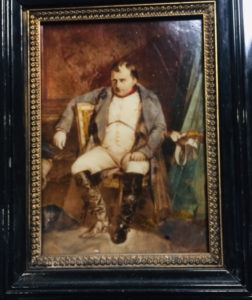 JS owns a painting on porcelain of Napoleon I, Emperor of the French (1769-1821), not painted in the way we usually picture the Emperor. Here we see a sad little man looking pudgy and despondent. The brass plaque underneath reads, erroneously, “Horace Vernet, Levachez fils.” However, this image is after a painting by Paul Delaroche, a brilliant historical painter of the mid-19th Century.
JS owns a painting on porcelain of Napoleon I, Emperor of the French (1769-1821), not painted in the way we usually picture the Emperor. Here we see a sad little man looking pudgy and despondent. The brass plaque underneath reads, erroneously, “Horace Vernet, Levachez fils.” However, this image is after a painting by Paul Delaroche, a brilliant historical painter of the mid-19th Century.
JS’s great uncles presented her with the little portrait in the late 1970’s when she visited relatives in Leipzig, behind the Iron Curtain. She smuggled the painting out by train in the lining of her luggage.
The full title of the original painting, owned today by the Leipzig Museum der Bildenden Kunste, dated 1845, is Napoleon I at Fontainebleau, 31 March 1814. The original isn’t as small as JS’s, but executed in a grander scale typical of the academic historical painting style. The original contrasts the banality of the Great Man’s pose in this painting: legs akimbo, slung arm, dirty boots, hat at feet, round belly, dismounted sabre. The soiled outfit comments on the future of the Empire. Schadenfreude plays a part here!
A German merchant commissioned the Napoleon Painting in 1845.
He wanted a piece commemorating the invading armies of Austria, the German States, Russia, Sweden, Prussia, Spain, and Britain, at the defeat of the Emperor. Delaroche researched Napoleon’s adjutant’s notebooks for the story of the despondent General when Napoleon saw the wheels of fate turning against him and France. The ensuing Treaty of Fontainebleau, signed April of 1814, ended Napoleon’s conquests and sent him to exile on Elba.
All this matters to JS, who wondered why her German relatives felt so proud of this little portrait on porcelain. Leipzig harbored a love-hate affair with Napoleon for generations. Leipzig and Prussia played a huge role in the defeat of Napoleon in 1812 and 1814. After that defeat citizens of Leipzig planed repeatedly for a great monument, until 100 years after in 1913 when they finally built the Monument of the Battle of Nations.
The monument stands on the site of one of the bloodiest battles of European history, and marks the retreat of the French army from Europe. However the monument also symbolizes German Nationalism. Now we know why Napoleon became a cult favorite of the citizens of Leipzig. Also why a despondent looking Napoleon, after the armies at Leipzig subdued him, appealed to people who felt a growing sense of German Nationalism in the mid19th century.
Paul Delaroche spent much of his career immortalizing Napoleon
All the royalty of Europe also enjoyed the cult of the Emperor for years. Hippolyte Paul Delaroche (1797-1856) was the man to immortalize Napoleon, for better or worse. His portraits became both famous and numerous. Although he never met the Emperor, and was a child during Waterloo himself, he was the premier painter of the Emperor. The artist painted the Emperor 20 years after Napoleon’s exile. People still considered the likeness of the Emperor a good one for someone with no real idea of what he looked like. Queen Victoria bought, from the artist’s agent, a version of Napoleon at Fontainebleau for Prince Albert in 1848. Today an engraved version of JS’s image hangs in Osborne House.
The question remains WHY Delaroche painted Napoleon so widely
Portraits range from Napoleon’s birth to his time as first consul, his battles, his horsemanship, his women, his children, and his defeat as a general. Maybe the artist found intrigue in such a figure’s climb, and fall from grace, and then punishment in fated exile. Perhaps the artist bonded with a Great Man who fell from grace…and his massive ego.
Most people know Delaroche’s Napoleon Crossing the Alps on that massive white steed. JS’s image appears the exact opposite: the anti-hero. No one looks at this image and says Napoleon didn’t get what he deserved!
One of the keys to Delaroche and his fascination with Napoleon is both stood the same diminutive height, and both suffered from a type of mania. So perhaps the artist, who was said to have ‘an unsettled nature’ identified with the Emperor. In any event JS’s portrait is worth $3500, without the connection to her family in Leipzig.
The painting referred to as “Napoleon Crossing the Alps” is, of course, by Jacques-Louis David. I assume the author simply slips up here in attributing it to Delaroche, but the mistake should be corrected if the paragraph is to make any sense.
Napoleon Crossing the Alps is by Jacques-Lois. Bonaparte crossing the alps is by Delaroche.